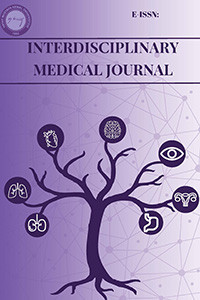GENDEN TEDAVİYE YENİ YAKLAŞIMLAR: KODLAMAYAN NÜKLEİK ASİTLER
RNAi, miRNA, siRNA, ribozim, antisens oligonükleotit
New Approaches from Gene to therapies: Non-Coding Nucleic Acids
RNAi, miRNA, siRNA, ribozyme, antisense oligonucleotide,
___
- Fire A, Xu S, Montgomery MK, Kostas SA, Driver SE, Mello CC. Potent and specific
- genetic interference by double-stranded RNA in Caenorhabditis elegans. Nature.
- ; 391:806-11.
- Paulson H, Gonzalez-Alegre P. RNAi gets its prize. Lancet Neurol. 2006; 5:997-9.
- Kurreck, J. Antisense Technologies. Improvement through novel chemical
- modifications. Eur J Biochem. 2003; 270:1628-1644
- Dykxhoorn DM, Novina CD, Sharp PA. Killing the messenger: short RNAs that
- silence gene expression. Nat Rev Mol Cell Biol. 2003; 4:457-67.
- Tolia NH, Joshua-Tor L. Slicer and the argonautes. Nat Chem Biol. 2007;3(1):36-43.
- Grishok A, Pasquinelli AE, Conte D, Li N, Parrish S, Ha I, Baillie DL, Fire A, Ruvkun
- G, Mello CC.Genes and mechanisms related to RNA interference regulate expression
- of the small temporal RNAs that control C elegans developmental timing. Cell. 2001;
- :23-34.
- Mello CC, Conte D Jr. Revealing the world of RNA interference. Nature. 2004;
- :338-42.
- Lee YS, Dutta A. MicroRNAs in cancer. Annu Rev Pathol Mech Dis. 2009; 4:199-
- -
- Zeng Y, Yi R, Cullen BR. MicroRNAs and small interfering RNAs can inhibit mRNA
- expression by similar mechanisms. Proc Natl Acad Sci USA. 2003; 100:5779-84.
- Hammond SM, Bernstein E, Beach D, Hannon GJ. An RNA-directed nuclease
- mediates post-transcriptional gene silencing in Drosophila cells. Nature. 2000;
- :293-6.
- Zamore PD, Tuschl T, Sharp PA, Bartel DP. RNAi: double-stranded RNA directs the
- ATP-dependent cleavage of mRNA at 21 to 23 nucleotide intervals. Cell. 2000;
- :25-33.
- http://www.pulmonarycirculation.org/viewimage.asp?img=PulmCirc_2011_1_3_357_
- _f2.jpg 05.12.2013.
- Caudy AA, Myers M, Hannon GJ, Hammond SM. Fragile X-related protein and VIG
- associate with the RNA interference machinery. Genes Dev. 2002; 16:2491-6.
- Hamilton AJ, Baulcombe DC. A species of small antisense RNA in posttranscriptional
- gene silencing in plants. Science. 1999; 286(5441):950–2.
- Aigner A. Gene silencing through RNA interference (RNAi) in vivo: strategies based
- on the direct application of siRNAs. J Biotechnol. 2006; 124(1):12-25.
- Cowland JB, Hother C, Gronbaek K. MicroRNAs and cancer. APMIS. 2007;
- :1090-106.
- Krützfeldt J, Rajewsky N, Braich R, Rajeev KG, Tuschl T, Manoharan M, Stoffel M.
- Silencing of microRNAs in vivo with ‘antagomirs’. Nature. 2005; 438:685-9.
- Morris KV, Rossi JJ. Lentiviral-mediated delivery of siRNAs for antiviral therapy.
- Gene Ther. 2006; 13:553-8.
- Grimm D, Kay MA. Therapeutic short hairpin RNA expression in the liver: viral
- targets and vectors. Gene Ther. 2006; 13:563-75.
- Kim DH, Rossi JJ. Strategies for silencing human disease using RNA interference.
- Nature Rev Genet. 2007; 8:173-84.
- Ozvaran MK. Malign Mezotelyomada Gen Tedavisi. Toraks Dergisi, 2004; 5(2):110-
- -
- Juliano RL, Dixit VR, Kang H, Kim TY, Miyamoto Y, Xu D. Epigenetic manipulation
- of gene expression: a toolkit for cell biologists. J Cell Biol. 2005; 169:847–857.
- Zamecnik PC, Stephanson ML. Inhibition of Raus sarcoma virus replication and cell
- transformation by a spesific oligodeoxynucleotide. 1978;75:280-4.
- Zamaratski E, Pradeepkumar PI, Chattopadhyaya J. A critical survey of the structurefunction
- of the antisense oligo/RNA heteroduplex as substrate for RNase H. J
- Biochem Biophys Methods. 2001; 48:189–208.
- Maeda Y, Sheffield AM, Smith RJ.Therapeutic regulation of gene expression in
- the inner ear using RNA interference.Adv Otorhinolaryngol. 2009; 66:13-36.
- Dass CR. Liposome-mediated delivery of oligodeoxynucleotides in vivo. Drug Deliv.
- ; 9:169–180.
- Lilley DM. Structure, folding and mechanisms of ribozymes. Curr. Opin. Struct. Biol.
- ; 15:313-323.
- Serganov A, Patel DJ. Ribozymes, riboswitches and beyond: regulation of gene
- expression without proteins. Nat Rev Genet. 2007; 8:776-790.
- Kruger K, Grabowski PJ, Zaug AJ. Sands J, Gottschling DE, Cech TR. Self-splicing
- RNA: autoexcision and autocyclization of the ribosomal RNA intervening sequence of
- Tetrahymena. Cell. 1982; 31:147-157.
- Chen X, Li N, Ellington AD. Ribozyme catalysis of metabolism in the RNA world.
- Chem Biodivers. 2007; 4:633-655.
- Strobel SA, Cochrane JC. RNA catalysis: ribozymes, ribosomes, and riboswitches.
- Curr. Opin. Chem. Biol. 2007; 11:636-643.
- Opalinska JB, Gewirtz AM. Nucleic-acid therapeutics: basic principles and recent
- applications. Nat. Rev. Drug Discov. 2002; 1:503-514.
- Kore AR, Vaish NK, Kutzke U, Eckstein F. Sequence specificity of the hammerhead
- ribozyme revisited; the NHH rule. Nucleic Acids Res. 1998; 26:4116–4120.
- Akashi H, Matsumoto S, Taira K. Gene discovery by ribozyme and siRNA libraries.
- Nature Reviews Molecular Cell Biology. 2005; 6(5):413-22.
- Karaboz I, Çolak C. Antisens Teknolojisi. Orlab On-Line Mikrobiyoloji Dergisi. 2007;
- (2):14-37.
- Yayın Aralığı: Yılda 3 Sayı
- Başlangıç: 2023
- Yayıncı: Hatay Mustafa Kemal Üniversitesi Tıp Fakültesi Dekanlığı
Pınar Özuğuz, Seval Kaçar, Serap Polat, Sena Ulu, Şemsettin Karaca
Savaş Sarıkaya, Şafak Şahin, Lütfi Akyol, Turan Aktaş, Yavuz İntepe, Elif Börekçi, Yunus Yılmaz
BÜYÜK SAFEN VEN YETMEZLİĞİNDE ENDOVENÖZ LAZER ABLASYON TEDAVİSİ TECRÜBELERİMİZ
Özgür Bulut, Ümit Halıcı, Atilla Kanca, Soner Sanioğlu
GENDEN TEDAVİYE YENİ YAKLAŞIMLAR: KODLAMAYAN NÜKLEİK ASİTLER
Hasret ECEVİT, Sedat MOTOR, Müzeyyen İZMİRLİ
DÜŞME HİKAYESİ BULUNAN BİR ATEŞLİ SİLAH YARALANMA OLGUSU; OLAY YERİ İNCELEMENİN ÖNEMİ
Hüseyin KAFADAR, Safiye KAFADAR
BİRİNCİ TRİMESTERDE SAPTANAN İKİ AKRANİ OLGUSU
Nesrin ATCI, Ayşe GÜLER, Hakan YERAL, Atilla KARATEKE, Hanifi BAYAROĞLU
ALOPESİ AREATADA TOPİKAL PSORALEN VE ULTRAVİOLE A FOTOKEMOTERAPİSİNİN ETKİNLİĞİNİN DEĞERLENDİRİLMESİ
Bilge Şen, Özlem Ekiz, Emine Rifaioğlu, Tuğba Şen, Asena Doğramacı
ANESTEZİDE MERKEZİ VENÖZ KATETERİZASYONDA ULTRASONOGRAFİ KULLANALIM MI? (ÜÇ OLGU SUNUMU)
Kasım TUZCU, Murat KARCIOĞLU, İşıl DAVARCI, Onur KOYUNCU, Sedat HAKİMOĞLU, Orcan HABİB, Çağla AKKURT, Selim TURHANOĞLU
